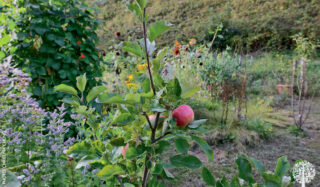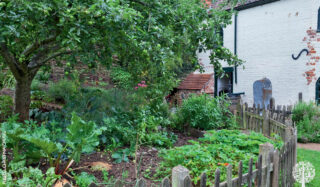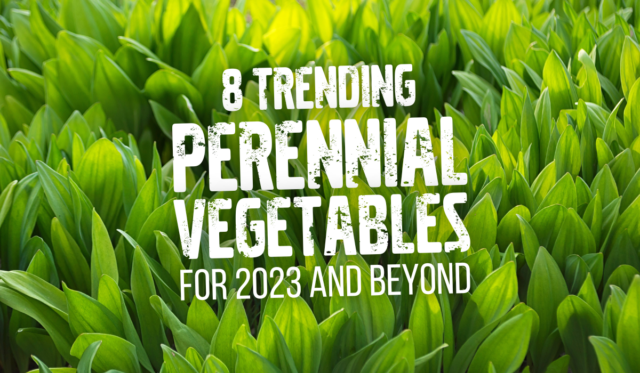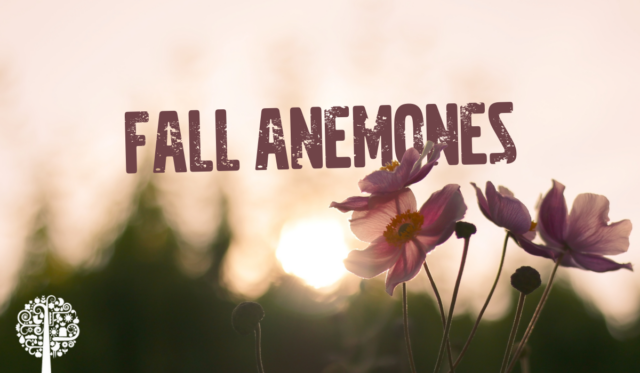
Building A Layered Edible Perennial Garden
How to Build a Layered Edible Perennial Garden
Look around a typical suburban neighborhood, and you’ll often see homes sitting on plots with grass, a specimen tree, and perhaps some shrubs or a foundation hedge. In the backyard or on the patio, some raised beds, flower pots, or a vegetable patch with tidy rows of crops growing. There’s nothing wrong with these traditional landscapes, but they can be better. If you ask Christina Chung, the future of growing is multi-layered, filling all available garden space with mostly edible perennial plants. The result is a garden bursting with biodiversity, increased soil health, and much less maintenance than what has become the standard.
Before You Stress – Build on What’s Already There
Don’t get too overwhelmed just yet. Creating a layered edible garden doesn’t mean removing everything you already have growing; Chung recommends building on what is there, adding different layers while mimicking nature as closely as possible.
“Mixing and matching is a fun way to approach it,” she says. “This is not a cookie-cutter approach. It’s your garden and your experience with your garden. What you can give to it is unique.”
Chung is a passionate gardener and educator (@fluent.garden) living in Vancouver, Canada. She is also the author of The Layered Edible Garden: A Beginner’s Guide to Creating a Productive Food Garden Layer by Layer. The book is about leaving the long, straight, boring rows of pest and disease-prone vegetables in the past and looking to the future: an interplanted polyculture where layers of edible plants out-compete weeds, share resources, and grow beautifully together while helping people become more self-sufficient.
Plant This, Not That
Taking a ‘plant this, not that’ approach, Chung emphasizes the importance of replacing traditional landscape plants with edible perennials. For example, boxwoods serve a purpose in a formal landscape but not a layered edible garden.
“An edible shrub that looks somewhat similar is Chilean Guava,” Chung explains. “I talk about this a lot in the book; it’s one of my favorites in the garden. It’s a small shrub. It’s evergreen, with dark green leaves similar to boxwoods […] If you have a row or even a cluster of them, it’s quite impactful. They flower white and produce red berries towards the end of the growing season. You get almost four seasons of interest, depending on where you are, and you get to eat the fruit.”

Many Layers, Many Benefits
Like following permaculture practices to build a food forest, this gardening style typically includes plants of different statures from eight layers:
- Trees
- Sub-canopy trees
- Shrubs
- Vines
- Herbaceous perennials
- Annuals
- Ground covers
- Edible roots
Perennial plants are investment pieces that cost more at the outset and take time to establish. But once they do, Chung says gardeners are rewarded with lush, eco-friendly, and productive landscapes that don’t require much labour. Perennial plants return each year with prolific harvests. Intensely planting them prevents weeds from growing, requires less watering, and boosts soil health by keeping the ground covered and undisturbed, unlike pulling out and planting annual crops. Plus, propagating new plants from established perennials is easy, ensuring you have plenty of plants and perhaps enough to share with friends and family. More layers!
Chung is particularly proud of an apple bed she has created in her home garden, which includes a dwarf apple tree and, below that, shrubs with colourful flowers to add visual interest and soften the look. Under the shrubs, she has flowers. She’s always experimenting with different edible treasures and was particularly happy with how her Swiss chard looked when incorporated into the bed one year. Her ground cover of choice is fast-spreading and deer-resistant creeping thyme.
“Thyme is one of the groundcovers that I rely heavily on because they flower in the spring through the summer and sometimes into fall,” she says. “They’re a reliable ground cover with the right soil conditions.”
Strawberries are also an excellent choice to cover the ground. Chung encourages gardeners to research various plants and experiment from season to season, growing what they love to eat and what makes sense in their regions. Keeping it simple is crucial; nothing in the layered edible garden has to be exotic. Her book includes several examples of plants under each of the eight categories.

Scalable Garden Projects
You don’t need much property to try layered edible gardening, and you also don’t need to include plants from all eight layers. This gardening method is scalable to many different spaces and skill levels, meaning it’s always in reach.
“If you are just starting and you don’t know if this is a style that you can try, start small,” she says. “It could be a container and doesn’t have to include all eight layers. Some of the most successful and productive plantings only have three, four, or five elements.”
For example, in her book, Chung suggests a five-layered edible garden including a hops vine as a climber, roses as shrubs, hostas and sage in the perennial layer, kale, chard, and violas in the annual layer, and violets as ground cover. A simple container garden on a patio might include a fig tree, herbs, lettuce, pole beans, and more. Live in a city with a small balcony? You can still enjoy a layered edible container garden.
“It checks a bunch of boxes,” she says. “It gives you privacy. You get this vertical lush wall that gives you food. And you get this shaded layer underneath that keeps your cooler-loving crops happy.”
Chung says you can’t go wrong when designing your layered garden space, which relieves some of the stress of jumping into a new growing venture. But she warns there are a few golden rules or guidelines that essentially lean on the good old-fashioned gardening basics.
“If you have a plant that requires sun to thrive, look for a sunny spot,” she explains. “Otherwise, the plant may be unable to do well and produce the food you want. Ultimately, in an edible garden, you want those elements to harvest at some point.”
Baby Steps
Chung understands how easy it is to become overwhelmed by embarking on a new growing journey, so she suggests starting small, researching, and getting excited about creating a layered garden space. Her book, The Layered Edible Garden, is an excellent read and an inspiring place to start. Ultimately, Chung wants gardeners to remember that growing food is not a competition and that each garden is unique.
“I am gardening in a way, at a scale, in a style, that makes sense for me and my family,” she explains. “I think that’s really the big takeaway. Gardening is an experience; it’s not a rush to accomplish something to prove to someone.”
So, what can you do with your garden space? Remember, the future of growing food is multi-layered, and there’s no better time to start than the present.
The Layered Edible Garden: A Beginner’s Guide to Creating a Productive Food Garden Layer by Layer is available online at most major bookstores. Follow Christina Chung: @fluent.garden
Similar Articles
Eight Trending Perennial Vegetables For 2023 And Beyond
Have you heard about the perennial vegetable trend? Get started with this ultimate growing guide on Garden Culture Magazine.

Tight On Space? Try These Small Food Garden Solutions
Urban food gardeners, rejoice! You can still grow your own food in small spaces. Anne Gibson offers tips and tricks for squeezing plants into tight areas.

Plant Of The Month: Fall Anemones Are A Whimsical And Lovely September Perennial
Fall Anemones are September's Plant of the Month. Discover more about Fall Anemones and how to get the most out of them now.

LEAVE A COMMENT

- Catherine Sherriffs
